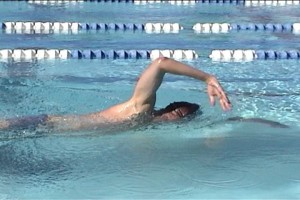 It’s easy to get bogged down in the technicalities associated with executing a proper swim stroke recovery and forget the guiding principle behind it. And that is . . . wait for it . . . to recover.
It’s easy to get bogged down in the technicalities associated with executing a proper swim stroke recovery and forget the guiding principle behind it. And that is . . . wait for it . . . to recover.
From the time your hand exits the water to the time it enters, you are giving your arm the opportunity to rest. Or, you should be. There is nothing to be gained by tension in the arms during the recovery phase of the swim stroke. Nothing.
Why do we carry tension in the recovery?
I can understand why it happens. You rush out of the office, drive to the pool in traffic, forget your swim suit, curse yourself for your stupidity, drive home to get it, curse yourself again because of all the planning you did to try to get ahead of the game and bring your swim stuff to work and it was all for naught, you finally arrive at the pool, dash into the locker room, check your watch, 30 minutes until your conference call, suit on, cap on, goggles on, sprint out to the pool, every lane full, ask first person if they mind circling and they say yes, crap, move to next lane, person floating on a noodle, can I share a lane, well, yes, I guess you can, you shrug, better than nothing, jump in, first lap, goggles leak, check watch, 20 minutes left, screw the warm-up, screw the drills, I need a workout damn it, 10 x 100 on 1:30 go, go, go, drive that hand into the water, spear it hard, pull like the devil, whip hand past the hip, contract every arm muscle you have and throw the arm forward again, yes, yes, yes, you’re working hard, squeezing every drop out of your limited swimming time, breathing in gulps, you drive your hand into the wall on that final stroke. Done! Yes! Another successful swim workout!
Whew . . .
Ok, then. So let’s breathe in deeply . . . hold it a moment . . . there . . . now let it go . . . slowly . . . ahhhhh.
Better now.
So, yeah, there are many reasons a rigid recovery happens, none of which will benefit you in the long run. And let me emphasize, lest you think otherwise, a tense recovery will not help you swim faster. It will help you fatigue faster, but that’s about it.
Focus points to think about during the recovery phase of the swim stroke:
- After you finish your pull, think of “releasing” your arm into recovery. Don’t pull it, lift it, throw it. Release.
- Let your elbow guide the recovery movement. Your forearm, hand, and fingers should hang from your elbow like a marionette arm. Loose. Relaxed. Like spaghetti. Resting. Recovering.
- When it’s time to enter, should you drive, spear, and grunt? No. Let your hand drop, slide, glide. Use gravity. Your hips and elbow are high. Use this potential energy. Let it all drop and your body will transition to the other side.
Fingertip drag
You know that fingertip drag drill your coaches always have you do? One of the many benefits of that drill is learning how to relax the arm during recovery. Your fingers should lazily drift through the water as they move forward. How relaxed can you make this movement? A drag and a drop. That’s what it should feel like. Slow down the recovery, drag and drop. Easy. Relaxed.
Warm-up
Warm-up is an ideal place to practice the fingertip drag drill. When you need to come down from work or whatever else life has thrown at you that day, do fingertip drag. For example, swim one length fingertip drag, followed by an easy length of quality freestyle, focusing on a relaxed recovery, on the way back. You can even do a few lengths of this this between your main sets to remind yourself to let go of the tension.
This isn’t just about the stroke looking pretty, it’s about energy management. Accumulated fatigue. Don’t let needless tension gobble up precious glycogen and fry your arms. Relax. And do what the stroke says you should. Recover.


